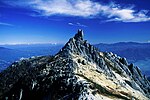Mount Hōō
| Mount Hōō | |
|---|---|
| 鳳凰山 | |
 Mount Hōō as seen from Ōkambazawa | |
| Highest point | |
| Elevation | 2,840 m (9,320 ft) |
| Listing | • List of mountains and hills of Japan by height • 100 Famous Japanese Mountains |
| Coordinates | 35°42′06″N 138°18′16″E / 35.70167°N 138.30444°E |
| Naming | |
| Language of name | Japanese |
| Geography | |
| Parent range | Akaishi Mountains |
| Geology | |
| Mountain type | Granite |
Mount Hōō (鳳凰山, Hōō-zan) is located in the western portion of Yamanashi Prefecture, Japan. Because the mountain has three peaks, it is also called Hōō Sanzan (鳳凰三山). It is in Minami Alps National Park[1] and is one of the 100 Famous Japanese Mountains.
Outline
Mount Hōō has three peaks:
| Image | Mountain | Elevation | Triangulation station |
Note |
|---|---|---|---|---|

|
Jizō-dake 地蔵岳 |
2,764 m (9,068 ft) | The rock of the huge Granite in the top is called Obelisk. Mountain hut Hōō in the east | |

|
Kannon-dake 観音岳 |
2,840 m (9,318 ft) | (stopped)[2] | the highest point |

|
Yakushi-dake 薬師岳 |
2,780 m (9,121 ft) | . Mountain hut Yakushi-dake in the south |
Mount Hōō is separated from most of the other mountains in the Akaishi range, giving a wider view of the surrounding mountains. Also, most mountains in the range have a reddish-brown color ("Akaishi" means "red stone" in Japanese), but Mount Hōō and Mount Kaikoma are the two exceptions, as they are granite mountains.
History
Metal ore was found in the mountain during the Sengoku period and, by the Edo period, the mountain was exploited for its metals and forest products.
- In 1904, Walter Weston became the first to climb the obelisk on top of Jizōdake.[3]
- On June 1, 1964, this area was specified to the Minami Alps National Park.[1]
- In 1990, Sumie Tanaka (田中澄江 Tanaka Sumie) completed New Flowers of the 100 Mountains, which featured many of the alpine plants on Mount Hōō.[4]
Geography
Nearby mountains
Mount Hōō is on the subridge (from Mount Komatsu) of the main ridge line in the northern part of the Akaishi Mountains.
| Image | Mountain | Elevation | Distance from the Top |
Note |
|---|---|---|---|---|

|
Mt. Senjō 仙丈ヶ岳 |
3,033 m (9,951 ft) | 11.1 km (6.9 mi) | 100 Famous Japanese Mountains |

|
Mt. Kaikoma 甲斐駒ヶ岳 |
2,967 m (9,734 ft) | 8.7 km (5 mi) | 100 Famous Japanese Mountains |

|
Mt. Asayo アサヨ峰 |
2,799 m (9,183 ft) | 6.6 km (4.1 mi) | |

|
Mt. Kita 北岳 |
3,193 m (10,476 ft) | 6.7 km (4.2 mi) | Tallest of the Akaishi Mountains 100 Famous Japanese Mountains |

|
Mt. Fuji 富士山 |
3,776 m (12,388 ft) | 56.4 km (35.0 mi) | Tallest mountain in Japan 100 Famous Japanese Mountains |
Rivers
The mountain is the source of the following rivers, each of which flows to the Pacific Ocean.
- Noro River (a tributary of the Fuji River)
- Ōtake River, Kotake River (tributaries of the Tenryū River)
Gallery
-
Mount Hōō and Mount Fuji from Mount Komatsu at the sunrise
-
Mount Hōō and Mount Fuji from Mount Kaikoma
-
Mount Hōō
-
Mount Yakushidake from Mount Kannondake
References
- ^ a b "Minami Alps National Park". Ministry of the Environment (Japan). Archived from the original on 2011-03-22. Retrieved 2010-11-27.
- ^ Triangulation station(rank 2) was stopped."Inspection service of the information". Geospatial Information Authority of Japan. Archived from the original on 2009-06-09. Retrieved 2010-11-28.
- ^ The Playground of the Far East in 1918 by Walter Weston, translated into Japanese Visit to Japanese Alps again (日本アルプス再訪), Heibonsha Library, in 1996 new edition, ISBN 4-582-76161-5, Pg. 454
- ^ New Flowers of the 100 Mountains(新・花の百名山), Bunsyunbunko, in 1995 by Sumie Tanaka, ISBN 4-16-731304-9




